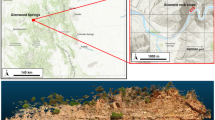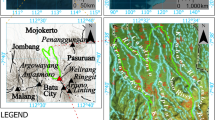Abstract
The development of laser scanning is one of the surveying methods, which able to produce a digital surface in a short period. The good results of digital surface must be followed by specific procedures, for example, interpolation algorithm and filtering methods. The improvement in information technology has influenced the growing development and application of laser scanning technique in order to fulfill the user needs. Laser scanning resolution might have an effect on the results of slope mapping studies. The objective of this paper is to evaluate the results of different laser scanner resolutions in producing a slope map. This study was conducted at Cameron Highlands, Pahang, Malaysia. Two site locations were identified for this study due to the condition of the slope characteristics that provides a more accurate assessment. Topcon GLS1500 is being used for data collection at both sites, and several control points were established using real-time kinematic global positioning system. The storage of point clouds was increased when the resolution value is decreased. The results of laser scanner were analyzed based on different laser scanner resolutions. It can be concluded that laser scanner resolutions do have an effect on slope mapping accuracies. Determination of the appropriate resolution for specific applications can be identified in this study.
Similar content being viewed by others
References
Bae K.H.: Evaluation of the convergence region of an automated registration method for 3D laser scanner point clouds. Sensors 9(1), 355–375 (2009)
Jones, R.R.; McCaffrey. K.J.: Capturing detailed outcrop geology using terrestrial laser scanning (Lidar) and other digital technologies: current status and future directions. American Geophysical Union, Fall Meeting (2007)
Sui, L.; Wang, X.; Zhao, D.; Qu, J.: Application of 3D laser scanner for monitoring of landslide hazards. The International Archives of the Photogrammetry, Remote Sensing and Spatial Information Sciences. vol. XXXVII. Part B1. Beijing (2008)
Tahar K.N., Ahmad A., Wan Mohd Akib W.A.A.: The Potential of multi-rotor UAV Technology in landslide mapping. J. Mod. Phys. Appl. 1, 23–37 (2012)
Yilmaz H.M., Yakar M., Yildiz F., Karabork H., Kavurmaci M.M., Mutluoglu O., Goktepe A.: Determining rates of erosion of an earth pillar by terrestrial laser scanning. Arab. J. Sci. Eng. 35(2A), 163–172 (2010)
Embry, C.; Hardy, M.; Nickerson, B.; Manning, N.; Goodyear, D.: Subsea monitoring-high resolution 3D laser imaging for inspection, maintenance, repair and operations. Offshore Technology Conference, Houston (2012)
Miyazaki, T.; Kinoshita, K.; Takagi, M.: Accurate geometric transformation of laser scanner data for landslide monitoring. Infrastructure Systems Engineering, Kochi University of Technology Tosayamada-city, Kami-shi, Kochi, pp. 782–8502 (2008)
García M., Danson F.M., Riańo D., Chuvieco E., Ramirez F.A., Bandugula V.: Terrestrial laser scanning to estimate plot-level forest canopy fuel properties. Int. J. Appl. Earth Obs. Geoinf. 13, 636–645 (2011)
Kinoshita, K.; Miyazaki, T.; Takagi, M.: Accurate evaluation of laser scanner data depending on location of GCPs for monitoring landslide. In: Proceedings of the 26th Asian Conference on Remote Sensing (2007)
Lerones P.M., Fernández J.L., Gil A.M., García-Bermejo J.G., Casanova E.Z.: A practical approach to making accurate 3D layouts of interesting cultural heritage sites through digital models. J. Cult. Herit. 11, 1–9 (2010)
Rutzinger M., Pratihast A.K., OudeElberink S., Vosselman G.: Detection and modelling of 3D trees from mobile laser scanning data. Int. Arch. Photogramm. Remote Sens. Spat. Inf. Sci. 38, 520–525 (2010)
Hodge R.A.: Using simulated terrestrial laser scanning to analyse errors in high-resolution scan data of irregular surfaces. ISPRS J. Photogramm. Remote Sens. 65, 227–240 (2010)
Pollyea R.M., Fairley J.P.: Experimental evaluation of terrestrial Lidar-based surface roughness estimates. Geosphere 8, 222–228 (2012)
Roman C., Inglis G., Rutter J.: Application of structured light imaging for high resolution mapping of underwater archeological sites. IEEE Oceans, Sydney (2010)
Garcia-Selles D., Falivene O., Arbues P., Gratacos O., Tavani S., Munoz J.A.: Supervised identification and reconstruction of near-planar geological surfaces from terrestrial laser scanning. Comput. Geosci. 37, 1584–1594 (2011)
Hodgetts D.: Laser scanning and digital outcrop geology in the petroleum industry: a review. Mar. Pet. Geol. 46, 335–354 (2013)
Buckley S.J., Schwarz E., Terlaky V.: Combining aerial photogrammetry and terrestrial lidar for reservoir analog modeling. Photogramm. Eng. Remote Sens. 76, 953–963 (2010)
Buckley S.J., Howell J.A., Enge H.D., Kurz T.H.: Terrestrial laser scanning in geology: data acquisition, processing and accuracy consideration. J. Geol. Soc. 165(3), 625–638 (2008)
Buckley S.J., Dunlap D.B., Wood L.J., Flaig P.P.: Lidar intensity as a remote sensor of rock properties. J. Sendiment. Res. 81, 339–347 (2011)
Buckley S.J., Kurz T.H., Howell J.A., Schneider D.: Terrestrial lidar and hyperspectral data fusion products for geological outcrop analysis. Comput. Geosci. 54, 249–258 (2013)
Rüther H., Chazan M., Schroeder R., Neeser R., Held C., Walker S.J., Matmon A., Kolska Horwitz L.: Laser scanning for conservation and research of African cultural heritage sites: the case study of Wonderwerk Cave, South Africa. J. Archaeol. Sci. 36, 1847–1856 (2009)
Rönnholm, P.; Honkavaara, E.; Litkey, P.; Hyyppä, H.; Hyyppä, J.: Integration of laser scanning and photogrammetry. ISPRS workshop on laser scanning 2007 and SilviLaser 2007, 12.–14.9.2007, Espoo, The International Archives of the Photogrammetry, Remote Sensing and Spatial Information Sciences. vol. XXXVI, Part 3, pp. 355–362 (2007)
Jaakkola A., Hyyppä J., Kukko A., Yu X., Kaartinen M., Lehtomäki M., Lin Y.: A low-cost multi-sensoral mobile mapping system and its feasibility for tree measurements. ISPRS J. Photogramm. Remote Sens. 65(6), 514–522 (2010)
Lichti D.D., Jamtsho S.: Angular resolution of terrestrial laser scanners. Photogramm. Rec. 21(2006), 141–160 (2006)
Kukko A., Kaartinen H., Hyyppä J., Chen Y.: Multiplatform mobile laser scanning: usability and performance. Sensors 12(9), 11712–11733 (2012)
Kaartinen H., Hyyppä J., Kukko A., Jaakkola A., Hyyppä H.: Benchmarking the performance of mobile laser scanning systems using a permanent test field. Sensors 12(9), 12814–12835 (2012)
Monserrat O., Crosetto M.: Deformation measurement using terrestrial laser scanning data and least squares 3D surface matching. ISPRS J. Photogramm. Remote Sens. 63, 142–154 (2008)
Vaaja M., Hyyppä J., Kukko A., Kaartinen H., Hyyppä H., Alho P.: Mapping topography changes and elevation accuracies using a mobile laser scanner. Remote Sens. 3(3), 587–600 (2011)
Tahar, K.N.; Ahmad, A.: Unmanned aerial vehicle technology for low cost landslide mapping. SEASC 2011 PWTC, Kuala Lumpur, Malaysia (2011)
Author information
Authors and Affiliations
Corresponding author
Rights and permissions
About this article
Cite this article
Tahar, K.N. Investigation on Different Scanning Resolutions for Slope Mapping Studies in Cameron Highlands, Malaysia. Arab J Sci Eng 40, 245–255 (2015). https://doi.org/10.1007/s13369-014-1513-9
Received:
Accepted:
Published:
Issue Date:
DOI: https://doi.org/10.1007/s13369-014-1513-9




